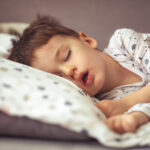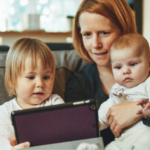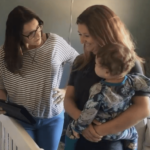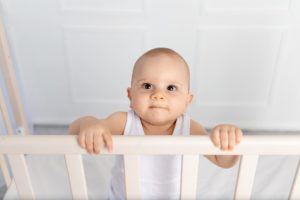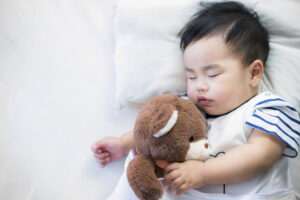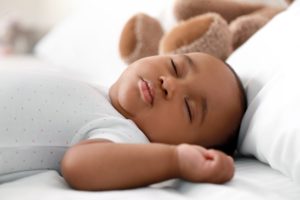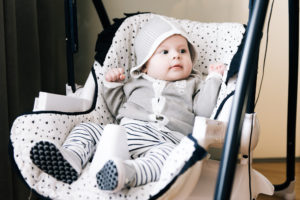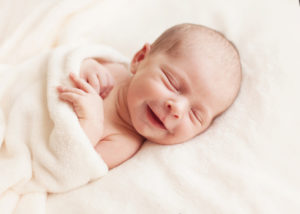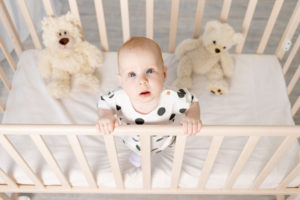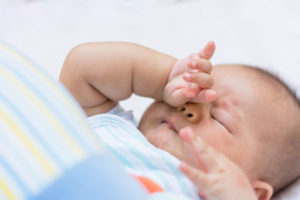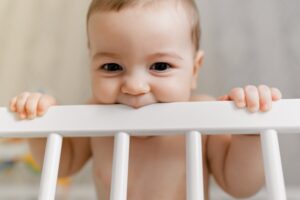When you buy through our links, we may earn a commission. Products or services may be offered by an affiliated entity. Learn more.
When Can Your Baby Sleep With a Blanket?
First-time parents may wonder when their baby can sleep with a blanket. Although a parent might imagine that sleeping with a blanket can comfort their child, a blanket may endanger an infant if introduced too early. We cover how to create a safe sleeping environment for your baby, including when to introduce a blanket, information about swaddling, and how to establish a consistent nightly routine.
Is It Safe for Babies to Sleep With Blankets?
It is not safe for babies less than 12 months old to sleep with blankets, according to the American Academy of Pediatrics.
Risks of Introducing a Blanket Too Quickly
Introducing a blanket into your infant’s sleep space too early — any time during the baby’s first year of life — increases the likelihood of accidental suffocation . Including any soft items in the crib, such as a blanket, pillow, crib bumper, or stuffed animal, can also put your baby at an increased risk of experiencing sudden infant death syndrome (SIDS) , the most common cause of infant death.
When Can a Baby Sleep With a Blanket?
The American Academy of Pediatrics advises that it is not safe for a baby to sleep with a blanket while they are less than a year old. SIDS most frequently affects babies between birth and six months , but deaths may still occur in infants up to 12 months of age.
Is Swaddling Safer for Babies Than Loose Blankets?
Swaddling refers to the practice of snugly wrapping a baby in a blanket for warmth and security, leaving only the child’s head exposed. Swaddling can be safer than giving your baby a blanket in the right circumstances, such as when the infant has not yet tried to roll over. This practice can allow the baby to feel comforted without direct parental contact and promote healthy sleep.
Swaddled babies rarely experience sudden death . Parents who swaddle their infants should always place them on their backs to sleep. Once the baby rolls over (or attempts to roll), typically around 2 months of age, parents should no longer use a swaddle due to the increased risk of suffocation faced when a baby sleeps on their belly. Some babies may roll over sooner than the 2 month window and parents should be careful to stop swaddling as soon as the baby rolls in any direction (even if only coming up on their side).
Help Your Baby Sleep Better With Pediatric Sleep Coaching
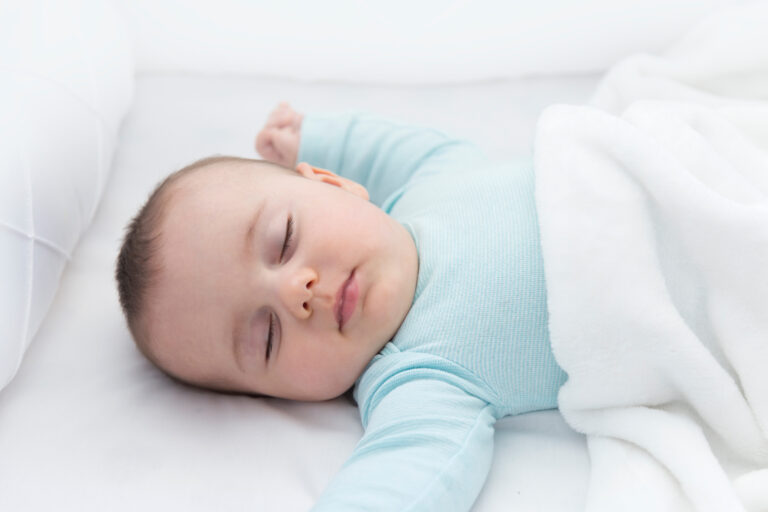
our partner at sleepdoctor.com
Learn More“Life-changing! My anxiety about my son’s sleeping habits were immediately reduced after talking to Sara. She went above and beyond to tailor a schedule to our goals, answer our questions, keep us on track, and check in to encourage us when we just thought we couldn’t do it anymore.”
Rachael B. – Verified Customer
How Can I Make Sure My Baby Is Warm Without a Blanket?
There are many ways parents can ensure an ideal temperature for their sleeping babies without using blankets.
Layer Your Baby’s Clothing
Rather than giving your baby a blanket, try layering their clothing for additional warmth through the night. To safely layer your baby’s sleep attire, do not put on more than one layer beyond what an adult would wear in the same air temperature.
Adjust Bedroom Temperature
Adjust your thermostat to between 68 and 72 degrees Fahrenheit in your baby’s room. An ideal sleeping temperature helps babies sleep through the night. Additionally, overheating may increase the likelihood of SIDS, making a comfortable room temperature that much more important.
Wrap Your Baby in a Swaddle or Sleep Sack
Swaddling your baby can give them added warmth on cold nights and help them feel more secure. A sleep sack or wearable blanket offers similar warmth and security but zips shut. It’s important to make sure your baby’s sleep sack is the right size, so it doesn’t come off or have additional fabric that can create a choking hazard. If you are layering, consider a swaddle or sleep sack as one layer of clothing. Again, make sure to stop swaddling once the baby begins rolling in any direction to avoid risk of suffocation.
Safe Sleep Guidelines for Babies
In addition to waiting until a baby is one-year-old to introduce sleeping with a blanket, parents can follow other guidelines to promote bedtime safety.
Always Place Your Baby on Their Back to Sleep
Until your baby is 12 months old, you should always place them on their back for both naps and night-time sleep. With time, they may begin to roll over on their own during sleep as a part of normal development. Even in this period, make sure to initially lay your baby on their back to sleep.
Put Your Baby to Sleep in a Crib
A crib or something similar, like a bassinet or bedside sleeper, is the safest place for your baby to sleep at night. Other furniture, like couches and chairs, can be very dangerous for infants. Even devices made for babies, like car seats, carriers, swings, and strollers, are not recommended for use as regular sleeping locations. If your baby falls asleep in one of these devices, it is best to place them on a firm mattress as soon as possible. Later, as an infant grows older, parents may prefer to introduce a toddler bed.
Use a Firm Mattress That Fits the Crib
Using a firm mattress in your baby’s crib can also reduce the risk of suffocation and keep temperatures down, ensuring a safe and comfortable sleep environment. The mattress should not be made of memory foam, which can be too soft or conforming and pose a safety hazard. Also, the firm mattress should fit snugly in the crib, with no space between it and the crib’s walls.
Keep the Crib Free of Objects, Including Bedding
Until your baby reaches 12 months of age, make sure that their crib is free of loose items, such as blankets, pillows, toys, and stuffed animals. These items increase the possibility of accidental suffocation. A pacifier, however, is fine to give to your baby and may even reduce the risk of SIDS.
A fitted sheet that remains snugly on the crib mattress, without the possibility of bunching or coming loose, is recommended. Sometimes parents mistakenly believe that blankets or bedding are okay if they are placed flat beneath the baby, rather than used to cover the baby. Aside from a fitted sheet, no bedding should be in the crib as a baby sleeps, regardless of where it is placed.
Do Not Sleep With Your Baby in Your Bed
Bed-sharing, or having your baby sleep in your bed with you, can increase your infant’s likelihood of injury or suffocation. As an alternative, try room-sharing. Sleeping in the same room with your baby while they are placed on a different surface, such as a crib or bassinet, helps minimize these risks while still allowing parents to monitor their baby’s needs. In fact, room-sharing is recommended for a baby’s first 6-12 months of life because it can decrease the risk of SIDS by up to 50%.
Set a Consistent Bedtime Routine
Sleep is a critical factor in early childhood development, and establishing a consistent bedtime routine promotes strong overall sleep health. Whether you read a book, sing lullabies, cuddle with your child, or give them a bath, consistent pre-sleep behaviors can help to establish a difference between night and day for babies and prepare them to drift off each night. Teaching proper sleep habits early in life and modeling healthy sleep behaviors is also important in creating a positive association with the experience.

Still have questions? Ask our community!
Join our Sleep Care Community — a trusted hub of sleep health professionals, product specialists, and people just like you. Whether you need expert sleep advice for your insomnia or you’re searching for the perfect mattress, we’ve got you covered. Get personalized guidance from the experts who know sleep best.
References
8 Sources
-
American Academy of Pediatrics. (2021, June 1). How to keep your sleeping baby safe: AAP policy explained. HealthyChildren.org., Retrieved November 24, 2021, from
https://www.healthychildren.org/English/ages-stages/baby/sleep/Pages/A-Parents-Guide-to-Safe-Sleep.aspx -
Gaw, C. E., Chounthirath, T., Midgett, J., Quinlan, K., & Smith, G. A. (2017). Types of objects in the sleep environment associated with infant suffocation and strangulation. Academic Pediatrics, 17(8), 893–901.
https://pubmed.ncbi.nlm.nih.gov/28723589/ -
Shapiro-Mendoza, C. K., Colson, E. R., Willinger, M., Rybin, D. V., Camperlengo, L., & Corwin, M.J. (2015). Trends in infant bedding use: National Infant Sleep Position study, 1993-2010. Journal of Pediatrics, 135(1), 10–17.
https://pubmed.ncbi.nlm.nih.gov/25452654/ -
Moon, R. Y., Darnall, R. A., Feldman-Winter, L., Goodstein, M. H., & Hauck, F. R. (2016). SIDS and other sleep-related infant deaths: Evidence base for 2016 updated recommendations for a safe infant sleeping environment. Pediatrics, 138(5)., Updated Recommendations for a Safe Infant Sleeping Environment. Pediatrics, 138(5), Article e20162940
https://pubmed.ncbi.nlm.nih.gov/27940805/ -
American Academy of Pediatrics. (2020, August 17). Swaddling: Is it safe?. HealthyChildren.org., Retrieved November 26, 2021, from
https://www.healthychildren.org/English/ages-stages/baby/diapers-clothing/Pages/Swaddling-Is-it-Safe.aspx -
McDonnell, E., & Moon, R.Y. Infant deaths and injuries associated with wearable blankets, swaddle wraps, and swaddling. Journal of Pediatrics, 164(5), 1152–1156.
https://pubmed.ncbi.nlm.nih.gov/24507866/ -
Maaks, D. L., Starr, N. B., Brady, M. A., Gaylord, N. M., Driessnack, M., & Duderstadt, K. G. (2020). Burns’ pediatric primary care. (7th ed.). Elsevier.
-
Mindell, J. A., & Williamson, A. A. (2018). Benefits of a bedtime routine in young children: Sleep, development, and beyond. Sleep Medicine Reviews, 40, 93–108.
https://pubmed.ncbi.nlm.nih.gov/29195725/


